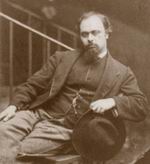
British painter and poet, son of an Italian Dante scholar who was professor of English in London University and of his Italian, highly literate wife, and brother of the poel Christina Rossetti.
At the age of 13 he began to study art, first at Sass’s art school in London, then in the Royal Academy Schools, resisting all attempts to teach him the academic bases of drawing.
In 1848 he persuaded Ford Madox Brown and Holman Hunf to accept him as pupil, embarked on his first painting, The Girlhood of Mary Virgin (1849), and was, with Hunt and Millais, one of the founders of the Pre-Raphaelite Brotherhood.
His sister Christina stars in Ecce Ancilla Domini, painted in 1850. That year he met Elizabeth Siddal whom he considered the ‘image of his soul’, brought her home to live with him, and drew and painted her untiringly until her death in 1862, though he also found other ‘stunners’ to immortalize in his art.
Ruskin became an admirer of his work in 1854 and engaged Rossetti as a teacher of drawing at the Working Men’s College. Rossetti was a wayward teacher but supplied very well what Ruskin hoped to present, an emphasis on innocent vision combined with romantic poetry.
When the original Brotherhood disintegrated, Rosseili allied himself to a younger group of painters and designers, notably Burne-Jones and William Morris who idolized him.
In 1857, he led them and others in painting murals, seenes from the Morle d’Arthur, in the new Oxford Union; these were never finished and were technically quite inept.
In 1862, he moved into Tudor House in Chelsea with his new model Fanny Cornforth. He was a partner in Morris’s firm and was beginning to earn well from his oil paintings.
Morris’s wife Jane was his mistress for a while as well as his frequent model. He was torn between his women and between his creative activities, his poetry interfering with his painting, his need to sell oil paintings conflicting with his desire to develop more private imagery, mostly in watercolors.
He became dependent on drink and drugs in spite of his growing success and being recognized, when Poems by D.G. Rossetti was published in 1871, as the country’s finest poet-painter.
In 1872, he attempted suicide. He recovered and continued to write and paint, often in poor mental and physical health.
Rossetti’s art was characterized by unusually rich color and by flattened compositions heralding the two-dimensionality of much progressive painting in France at the end of the century. Unlike his associates, he felt no urge to moralise through art: he preferred dreaming of a romantic world of medieval scenes and themes.
His only modern subject painting with a moral theme was Found begun in 1854, and developed through many studies but finished after his death by his friends. Rossetti’s work is best seen in the Tate Gallery, London, and in Birmingham’s City Museum and Art Gallery.
